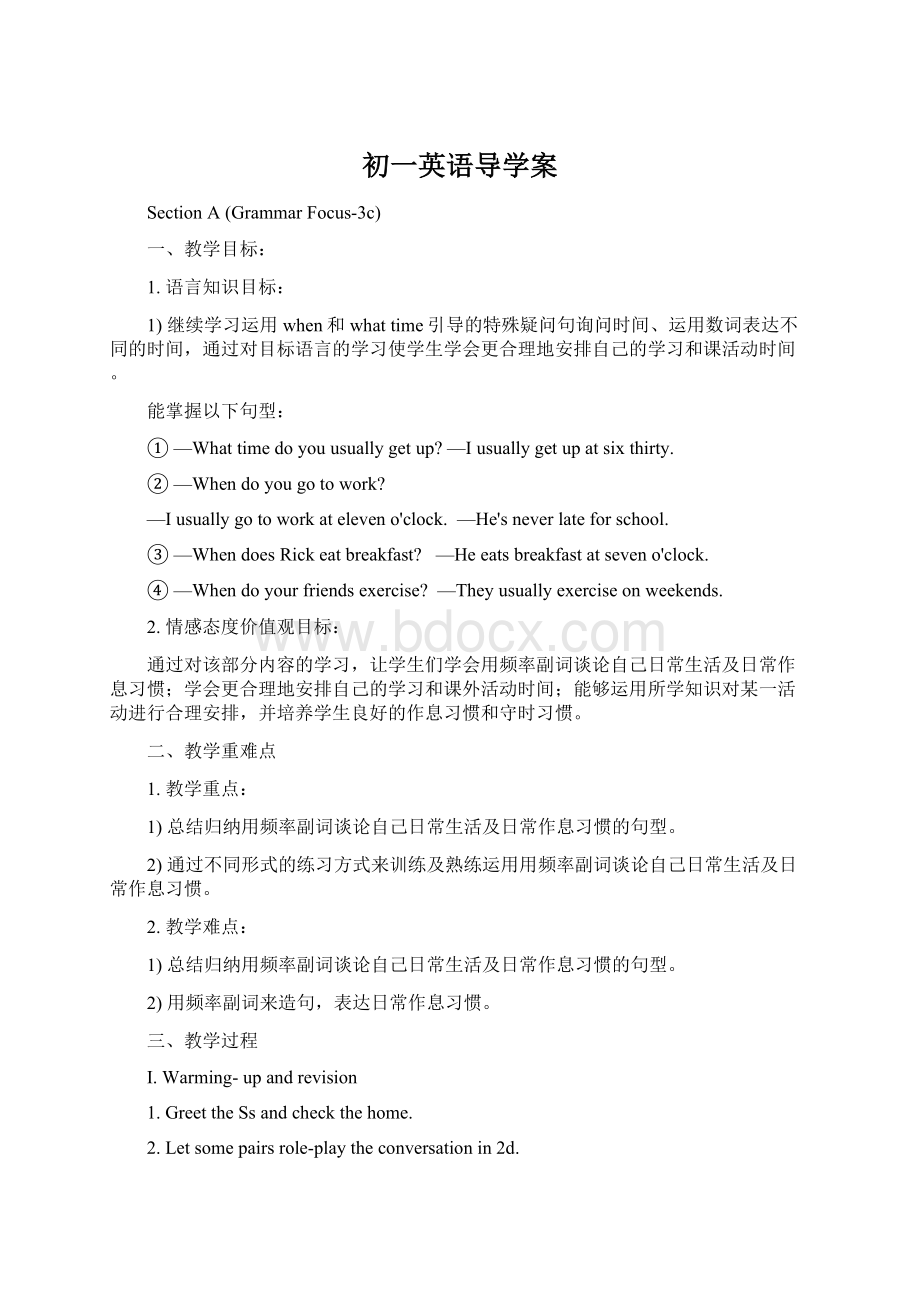初一英语导学案.docx
《初一英语导学案.docx》由会员分享,可在线阅读,更多相关《初一英语导学案.docx(9页珍藏版)》请在冰豆网上搜索。

初一英语导学案
SectionA(GrammarFocus-3c)
一、教学目标:
1.语言知识目标:
1)继续学习运用when和whattime引导的特殊疑问句询问时间、运用数词表达不同的时间,通过对目标语言的学习使学生学会更合理地安排自己的学习和课活动时间。
能掌握以下句型:
①—Whattimedoyouusuallygetup?
—Iusuallygetupatsixthirty.
②—Whendoyougotowork?
—Iusuallygotoworkateleveno'clock.—He'sneverlateforschool.
③—WhendoesRickeatbreakfast?
—Heeatsbreakfastatseveno'clock.
④—Whendoyourfriendsexercise?
—Theyusuallyexerciseonweekends.
2.情感态度价值观目标:
通过对该部分内容的学习,让学生们学会用频率副词谈论自己日常生活及日常作息习惯;学会更合理地安排自己的学习和课外活动时间;能够运用所学知识对某一活动进行合理安排,并培养学生良好的作息习惯和守时习惯。
二、教学重难点
1.教学重点:
1)总结归纳用频率副词谈论自己日常生活及日常作息习惯的句型。
2)通过不同形式的练习方式来训练及熟练运用用频率副词谈论自己日常生活及日常作息习惯。
2.教学难点:
1)总结归纳用频率副词谈论自己日常生活及日常作息习惯的句型。
2)用频率副词来造句,表达日常作息习惯。
三、教学过程
Ⅰ.Warming-upandrevision
1.GreettheSsandcheckthehome.
2.Letsomepairsrole-playtheconversationin2d.
Ⅱ.GrammarFocus.
1.下面是对用频率副词谈论自己日常生活及日常作息习惯的句型进行了总结。
同学们阅读GrammarFocus中的句子,然后做填空练习。
①你通常几点起床?
_____________________
②我通常六点半起床。
____________________
③他们几点穿好衣服?
___________________
④他们总是七点半穿好。
___________________
⑤里克在几点钟吃早饭?
____________________
…
2.Ssfinishoffthesentencesbythemselves,thenchecktheanswersbythemselves.
3.GiveSsaboutsometimetorememberthesentences.
4.语法探究:
LetSsreadthesentencesonthebigscreen.Trytofindtheanswerstothequestion.Andtrytolearnaboutthegrammarknowledge.
①可以看出,询问做某事的时间时,可以用_____________和_______两个疑
问词来询问。
②询问某人做某事的时间可以归纳为以下句型:
________+does+__________主语+动词短语?
或_____+does+___________主语+动词短语?
________+do+___________主语+动词短语?
或_______+do+___________主语+动词短语?
③在答语中always,usually,never频率词等放在主语与谓语动词之间。
5.ChecktheanswerswiththeSs.
Ⅲ.Practice
1.Lookat3a.TellSstowritequestionsoranswerswithalways,usually,ornever.
2.指导:
always,usuallyornever等副词在句子中的位置一般是在主语后面,行为动词前面。
要根据问句的内容确定答语的内容;或者根据答语的内容来确定问句的内容,特别是注意问句或答语的人称或数。
比如:
第一个问句所为you,因此回答应用第一人称“I”;Iusuallygetupatsixthirtyonschooldays.其他与之相类似。
Ⅳ.Writing
1.Lookat3b.Writesomethingyoualwaysdo,somethingyouusuallydoandsomethingyourneverdo.
2.Ssworkbythemselves.Trytowritedowntheirownsentences.
3.LetSsexchangetheirsentenceswiththeirpartners.Checkeachother'sanswers.
4.LetsomeSsreadtheirsentencesaloudtotheirclassmates.
Ⅴ.Interview
1.Lookattheboxbelow.Askastudentreadaloudthephrases.Now,interviewthreeofyourclassmates.Findoutwhattimetheydotheseactivities.Thengiveareporttotheclass.
Jenny
S2
S3
getup
7:
00
exercise
8:
00
eatdinner
6:
30
takeashower
9:
00
gotoschool
7:
30
2.First,askandansweryourfriend:
You:
Whattimedoyouusuallygetup?
Jenny:
Iusuallygetupat7:
00.
You:
Whattimedoyouexercise?
Jenny:
Iusuallyexerciseateight.
You:
Whattimedoyouusuallyeatdinner?
Jenny:
Iusuallyeatdinnerat6:
30.
You:
Whendoyouusuallytakeashower?
Jenny:
Iusuallytakeashowerat9:
00.
…
3.Thenwriteareportinyourexercisebook:
(提示:
让学生们一定要注意正确运用动词的第三人称单数形式。
)
Inourgroup,Jennyusuallygetsuplateonweekends.Shegetsupatseveno’clock.Shealwaysexercisesateighto’clock.Sheusuallyeatsdinneratsixthirty.Sheusuallytakesashoweratnineo’clock.Sheusuallygoestoschoolatseventhirtyonschooldays.
4.LetsomeSsreadtheirreporttotheclass.
Ⅵ.Exercises
Iftimeisenough,letSsdomoreexercisesonthebigscreen.
Homework
1.ReadthesentencesinGrammarFocus.
2.Askyourfamilymemberabouttheirdailyarrangement.Thenwriteareport.
板书设计
SectionB1a-2c
一、教学目标:
1.语言知识目标:
1)能掌握以下单词:
half,past,quarter,homework,run,walk,clean,quickly,either,either…or…,lot,lotsof,taste
2)能掌握以下句型:
①—WhendoesTomusuallygetup?
—Heusuallygetsupathalfpastfive.
②IeitherwatchTVorplaycomputergames.
③Ittastesgood.
2.情感态度价值观目标:
本部分的学习内容仍是对“日常作息时间”的询问和表达,学习内容贴近学生的生活。
通过互相询问和谈论自己或对方的作息时间安排和活动计划,可以培养学生良好的作息习惯和守时习惯。
二、教学重难点
1.教学重点:
1)让学生们掌握另外两种表达时间的方式。
2)掌握运用本节课所学习的一些日常活动的表达方式。
3)通过听、说、读的训练来提高学生们综合运用英语的能力。
2.教学难点
1)能听懂学习到的日常活动的时间按排。
2)通过阅读短文,综合学习运用本单元所学习的句型句式,提高学生们的综合英语水平。
三、教学过程
Ⅰ.Warming-upandrevision
1.GreettheSsasusual.
2.Checkthehomework.LetsomeSsreporttheirfamilymember'sdailyactivities.
Ⅱ.Presentation
出示一个可以转动时/分针的大钟,一边调整时间,一边询问学生时间“Whattime
isit?
”。
Ss:
It'ssixo'clock.It'sseventwenty.…
帮助学生们用past和to来回答时间:
It'stwentypastsix.
(1)数字表达法:
按照时间的顺序,用数词先说“时”,再说“分”。
如:
sixthirty六点半;sevenfifteen七点十五分;ninefifty-five九点五十五分。
(2)文字表达法:
先说“分”,再说“时”,中间加介词past(半点或半点以内,表示“超过”)、to(半点以上,表示“差”)。
如:
tenpastfive五点十分;。
quarterpastseven七点一刻;halfpastnine九点半;aquartertotwelve十二点差一刻,即十一点四十五分。
Ⅲ.Matching
1.Workon1a:
引导学生将用英语表达的时间与钟表上用数字表达的时间一一配对。
学生们将两个不同形式的时间配对。
2.然后,学生们将活动与时间一一配对,完成1a部分的教学任务。
Ⅳ.Pairwork
1.引导学生进行Pairwork活动,就1a所学的内容进行问答练习,运用所学的目标句型:
—Whendostudentsusuallyeatdinner?
—Theyusuallyeatdinnerataquartertosevenintheevening.等。
学生们进行Pairwork活动,就1a所学的内容进行问答练习,运用所学的目标句型来完成1b部分的教学任务。
2.Letsomepairsaskandansweraloud.
Ⅴ.Listening
1.LetSsreadtheactivitiesin1cfirst.Iftheyhaveanyproblem,theycanputuptheirhandsandaskforhelp.ThentellSstheywilllistentotherecordingandcircletheactivitiestheyhear.
2.播放2a部分的录音,引导学生一边听录音,一边圈出所听到的表示活动的词汇。
学生们听2a部分的录音,一边听录音,一边圈出所听到的表示活动的词汇,完成2a部分中的学习任务。
3.Checktheanswerswiththeclass.
Ⅵ.Listening
1.T:
Nowlet'slistentotherecordingagain.Writethetimenexttotheactivitiesyoucircledin1c.
2.再播放2a部分的录音,引导学生根据所听到的内容写出活动所发生的时间。
学生们再听2a部分的录音,根据所听到的内容写出活动所发生的时间,完成2b部分中的学习任务。
3.方法指导:
第一遍只听不写,第二遍边听,边写时间。
一定要将活动的内容听准确。
4.Checktheanswers:
Ⅶ.Talking
1.T:
Inourlives,someactivitiesarehealthy,butotheractivitiesareunhealthy.Forexample:
Takeawalkafterdinner;Exerciseeverymorning.Gotobedearlyandgetupearly.
2.Brainstorm
Let'sworkingroups.Talkaboutwhatactivitiesarehealthy.Whatactivitiesareunhealthy.
Makealistonapieceofpaper.Thenreportyourlisttotheclass.
3.Checktheactivitiesin2ayouthinkarehealthy.
Ⅷ.Reading
1.Fastreading.
TellSsthatTonyandMaryarebrotherandsister.Theyhavehealthyandunhealthyhabits.Whoishealthier?
Pleasereadthroughthepassagequicklyandtrytofindtheanswertothisquestion.
Whoishealthier(更健康)?
Ssreadthepassagequicklyandtrytofindtheanswertothetwoquestions.
(IthinkMaryishealthier.)
2.Carefulreading
Ssreadthepassageagainandcirclethehealthyactivitiesinthepassage.
学生们认真阅读短文,将自己认为是健康的活动下面划线。
3.LetsomeSsreadoutthehealthyactivities.Checktheanswerswiththeclass.
Ⅸ.Reading
Tellthestudentstoreadthepassageagainandwritedowntheunhealthyhabitsofeach
person.Thenthinkofhealthyactivitiesforthem.
阅读指导:
1)认真阅读短文,找出那些不太健康的生活习惯,并将它们写在横线上。
2)在小组中讨论一下,为他们提出更健康的习惯。
然后也写在横线上。
3)Letsomegroupsreporttheiranswerstotheclass.
2.综合学生们提出的意见,将最佳答案写在黑板上,让学生们参考。
Homework
1.Rememberthenewwordsandexpressionsintheperiod.
2.AskSstomakesentenceswiththemainphrasesinthisperiod.
either…or…;lotsof;taste…;
板书设计:
SectionB3a-SelfCheck
一、教学目标:
1.语言知识目标:
1)复习“日常作息时间”的询问和表达,学习内容贴近学生的生活。
2)通过多种形式的训练来训练学生们综合运用英语表达自己的或对方的作息时间安排和活动计划。
2.情感态度价值观目标:
让学生们学会谈论自己的日常生活及作息习惯;学会更合理地安排自己的学习和课外活动时间,并能够运用所学知识对某一活动进行合理安排。
因此,给学生提供一些实际活动的训练。
可以有效地帮助学生更好地学会制订作息计划。
二、教学重难点
1.教学重点:
复习“时间的询问和表达法”以及它在具体事务中的运用。
2.教学难点:
复习运用whattime和when引导的疑问句询问时间;运用数词表达时间。
三、教学过程
Ⅰ.Warming-upandrevision
1.GreettheSsasusual.
2.Checkthehomework.
3.Revision
1)Haveadictationofthenewwordsandexpressionslearnedyesterday.
2)LetsomeSsreadthepassagealoud.
Ⅱ.Reading
1.TellSsthisisadailyroutineofaJack.He'sastudentfromAustralia.Butthey'reinwrongnumbers.CanyoureadthesesentencesandmakeastoryaboutJack.
2.方法指导:
首先,应通读全部的句子,掌握每个句子的意思。
可知他例举了他一天来在不同的时间点上所做的事情;因此,同学们们可以按时间的先后,对这些活动来进行排序;因为第一句话已给标出,同学们也可以从第一句话开始,顺藤摸瓜,一步一步的将一天的活动串起来。
可知第一句话的意思为“我有一个很好健康的生活习惯”,可知接一下来应当是Jack例举他的生活习惯;对比这些时间点可知,第一项应是从起床“getup”开始。
所以第二条应是“Iusuallygetupearlyatsix.”一句。
其他的句子按时间的先后,逐步地确定了。
3.Checktheanswers:
(2,3,5,4,6,7,1,8,9)
Ⅲ.Writing
1.T:
NowJackwantstomakefriendswithyou.Andhewantstoknowaboutyourdailyroutine.Pleasewriteyourownroutineandsendanemailtohim.
2.写作指导:
首先,应在心中将自己日常的一些活动按时间的先后,列一清单。
然后,按时间的先后顺序一个事情一个事情的写清楚。
最后,再通读一遍自己的短文看有没有错误的地方。
3.Ssmakealistfirsttheytrytowritetheirownroutine.
4.Exchangetheirroutinesandcheckeachother'sanswers.
5.LetsomeSsreadtheirroutinestotheclassasamodel.
Ⅳ.Selfcheck1
1.Pleaselookatthewordsintheboxbelow.Firstyoushouldmakephraseswiththewordsintheboxes.
2.MakeamodelfortheSsfirst.tastegood尝起来味道很美
3.Ssworkingroupsandtrytomakephrasescorrectly.Writedowntheirphrasesonapieceofpaper.
4.Checktheanswerswiththeclass.